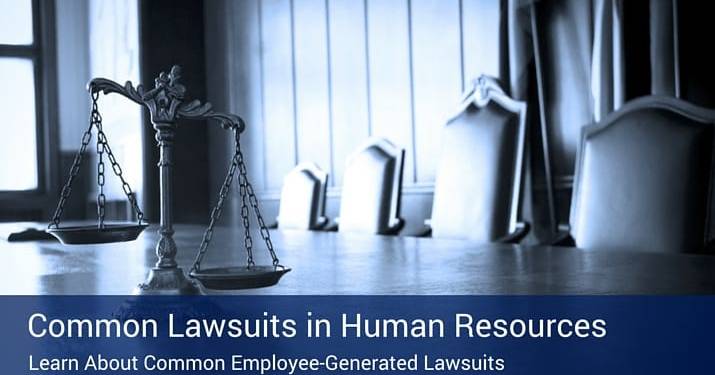Common Lawsuits that Human Resources Can Face
Last Updated May 6, 2019

Is your company prepared to defend itself in the face of a discrimination or other employee-generated lawsuit? Even with an equal opportunity employment policy, fair pay and a positive company culture, your firm could be at risk. That’s why it’s important to know about the most common lawsuits in human resources.
Based on official 2014 data from the Equal Employment Opportunity Commission (EEOC), it’s clear that charges of workplace discrimination occur fairly frequently across the United States:
- Charges of workplace discrimination in 2014 totaled 88,778.
- 133 lawsuits were filed on the merits (which involve an allegation of discrimination) by the EEOC’s Office of General Counsel.
- Monetary relief from these cases equaled $22.5 million.
The EEOC works to defend workers and remove barriers to equal employment opportunities, and as these statistics show, it found numerous employers to be in violation, with serious financial consequences.
Additional statistics reveal how often employees claimed discrimination based on protected status:
- Retaliation 42.8%
- Race (including harassment) 35%
- Sex (including pregnancy-related discrimination and sexual harassment) 29.3%
- Disability 28.6%
- Age 23.2%
- National origin 10.8%
- Religion 4%
- Color 3.1%
- Equal pay act: 1.1%
(Note: because some charges allege multiple bases, the percentages equal more than 100%).
5 Common Workplace Lawsuits
Employers are often surprised when employees bring suit against them, but it is possible to avoid these five common HR lawsuits:
- Personal Injury – Workplace injuries are very common. Typically, they are covered by the employer’s worker’s compensation insurance, but it’s still very important to create a culture of worker safety, respond to all safety issues and thoroughly train staff on workplace safety. These steps can help prevent charges that an employer’s negligence led to the employee’s injury.
- Overtime – Under the Fair Labor Standards Act (FLSA), non-salaried, hourly employees must be paid overtime in certain situations. Employers must accurately monitor the number of hours employees work, and be sure to pay overtime when required.
- Discrimination – As discussed above, charges of employer discrimination are quite common. Employees may file charges if they belong to a protected class and feel they have been treated unfairly. Protected classes under federal and state law include gender, race, religion, age, disability, national origin, color, family status, marital status, sexual orientation and veteran status. If an employee is of a protected class, is performing his or her job satisfactorily, and has suffered an adverse action (termination, reduced hours, lack of promotion, etc.) as a result of the protected status, then he or she could bring charges. The employer must then prove that any adverse action was for legitimate business reasons. To avoid this type of lawsuit, be aware of the law and make sure all business protocols are in compliance.
- Harassment – Harassment can take many forms, from sexually inappropriate comments by a manager, to bullying by a co-worker. Victims often file lawsuits when the employer fails to take action after the victim files a complaint. Preventing harassment starts with a strict policy and guidelines, outlined in an employee handbook. Frequent training and properly dealing with those who violate the policy can help create a safe work environment for all.
- Wrongful Termination – Employees may bring suit if they feel they were wrongfully terminated, such as in retaliation for a complaint or for taking leave to care for a loved one. Employers can defend charges by proving a termination was legal through accurate records of performance, communications, warnings and employee discipline.
Avoiding HR Lawsuits
Lawsuits against a company’s human resource practices can be costly, even if the employee loses his or her case. Avoiding the risk of an HR lawsuit is well worth the investment of time and money.
- Document, document, document – Make proper documentation a top priority. Record all employee reviews, performance evaluations, attendance records and other benchmarks. Be sure supervisors are honest and accurate in employee performance reviews, and create a paper trail that tells the whole story, particularly in cases of progressive discipline.
- Train managers and employees – From sexual harassment to worker safety, thorough training can go a long way. Supervisors should receive training in company policies, federal, state and local regulations and best practices. Employees should receive safety training, as well as training in how to maintain a welcoming work environment.
- Comply with the law – This may seem obvious, but keeping in compliance with all applicable local, state and federal laws regarding employment discrimination is absolutely necessary.
- Educate yourself – Employers are responsible for staying on top of changes to rules and regulations in the FLSA, state and local wage and hour laws and other standards.
- Maintain consistent policies – Be sure that policies apply evenly to all employees across the board. Demonstrating favoritism to a certain class or singling out workers you don’t like for disciplinary action are two invitations to discrimination charges. Avoid litigation by creating fair policies, ensure all employees adhere to the same standards and enforce all the rules.
Reduce the Risk of Common HR Lawsuits
While employee-generated lawsuits are increasing every year, it is possible to avoid the most common charges, such as discrimination, personal injury, wrongful termination, harassment and failure to pay overtime. By following the five steps above, HR professionals can be prepared to defend his or her company practices against a lawsuit.
